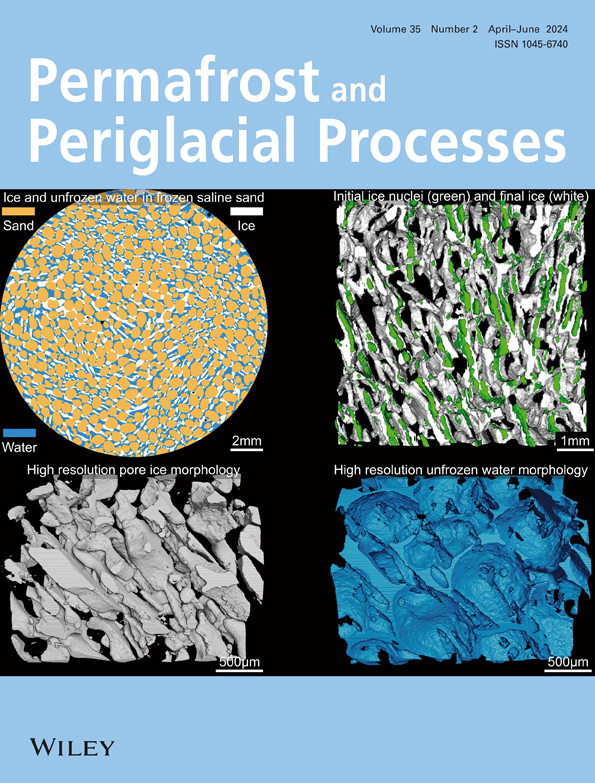冰周地形特征:东白令陆桥冰冻高地的多尺度假设分析
IF 3.3
3区 地球科学
Q2 GEOGRAPHY, PHYSICAL
引用次数: 2
摘要
一般地貌学关注的是连续陆地表面的几何形状,对识别地形“特征”很有用。假说已经在地貌学的几个分支领域中得到了广泛的应用,但尚未在已发表的冰周研究中得到广泛应用。本研究将假设分析应用于阿拉斯加育空-塔纳纳高地和印度河高地的几个未被冰川和被冰川覆盖的地点,以及白令陆桥东部的大片地区,在这些地区冰雪覆盖地形普遍存在。在0.25至100 km2的样本区域内,该地区未被冰川覆盖的地形具有明显不同于冰川覆盖地区的低热特征。冰冻地形表现出一种独特的凸向上的地形特征,这反映了比典型的成熟河流或冰川地形更大比例的参考固体(陆地块)保持完整。由于冰冻梯田的海拔位置略低于雪线位置并与雪线位置平行,因此它实际上是由上面的气候决定的,并且在该水平附近发展局部平面。与美国西南部地形的比较表明,白令陆桥东部的高地冰缘地形与温暖沙漠地貌景观中的林堡和山墙地形之间也存在实质性差异。我们得出结论,在白令陆桥无冰川地区存在典型的冰缘侵蚀地形,并且可以通过客观的方法进行检测和定量描述。本文章由计算机程序翻译,如有差异,请以英文原文为准。
Characteristic periglacial topography: Multi‐scale hypsometric analysis of cryoplanated uplands in eastern Beringia
General geomorphometry is concerned with the geometric form of the continuous land surface and can be useful for identifying topographic “signatures.” Hypsometry has found numerous applications in several subfields of geomorphology, but has not been used extensively in published periglacial work. Hypsometric analysis was applied in this study to several unglaciated and glaciated locales in Alaska's Yukon‐Tanana Upland and Indian River Upland physiographic sections, extensive areas of eastern Beringia in which cryoplanation landforms are ubiquitous. Never‐glaciated terrain in this region has a hypsometric signature distinctly different from that of glaciated areas within sample areas ranging in size from 0.25 to 100 km2. Cryoplanated terrain exhibits a distinctive convex‐upward hypsometric signature, a reflection of a greater proportion of the reference solid (land mass) remaining intact than in typical mature fluvial or glaciated terrain. Because the elevational position of cryoplanation terraces is slightly below and parallel with snowline position it is, in effect, climatically determined from above, and localized planar surfaces develop near that level. Comparison with terrain in the southwestern USA demonstrates that substantial differences also exist between the hypsometry of upland periglacial terrain in eastern Beringia and that of inselbergs and pediments in warm‐desert geomorphic landscapes, casting doubt on a suggestion that cryoplanation terraces and cryopediments in high‐latitude mountains could be inherited from past intervals of subtropical desert conditions We conclude that characteristic periglacial erosional topography exists in unglaciated areas of Beringia and can be detected and described quantitatively through objective methods.
求助全文
通过发布文献求助,成功后即可免费获取论文全文。
去求助
来源期刊
CiteScore
9.70
自引率
8.00%
发文量
43
审稿时长
>12 weeks
期刊介绍:
Permafrost and Periglacial Processes is an international journal dedicated to the rapid publication of scientific and technical papers concerned with earth surface cryogenic processes, landforms and sediments present in a variety of (Sub) Arctic, Antarctic and High Mountain environments. It provides an efficient vehicle of communication amongst those with an interest in the cold, non-glacial geosciences. The focus is on (1) original research based on geomorphological, hydrological, sedimentological, geotechnical and engineering aspects of these areas and (2) original research carried out upon relict features where the objective has been to reconstruct the nature of the processes and/or palaeoenvironments which gave rise to these features, as opposed to purely stratigraphical considerations. The journal also publishes short communications, reviews, discussions and book reviews. The high scientific standard, interdisciplinary character and worldwide representation of PPP are maintained by regional editorial support and a rigorous refereeing system.

 求助内容:
求助内容: 应助结果提醒方式:
应助结果提醒方式:


